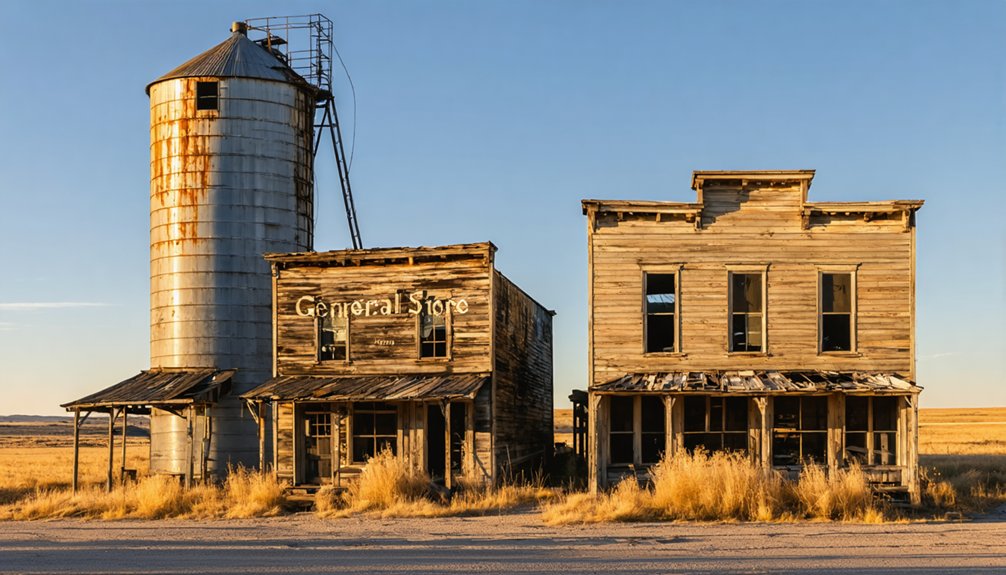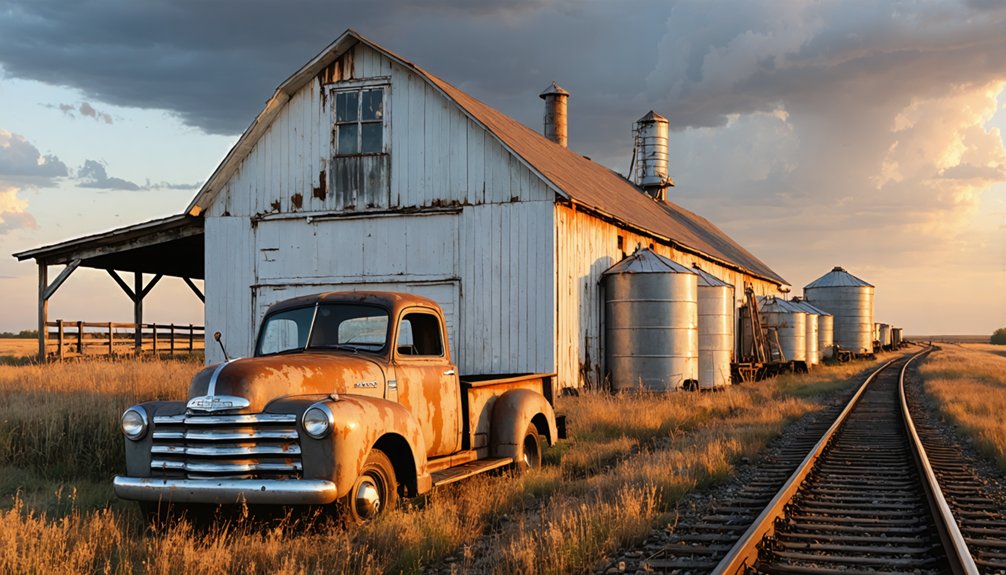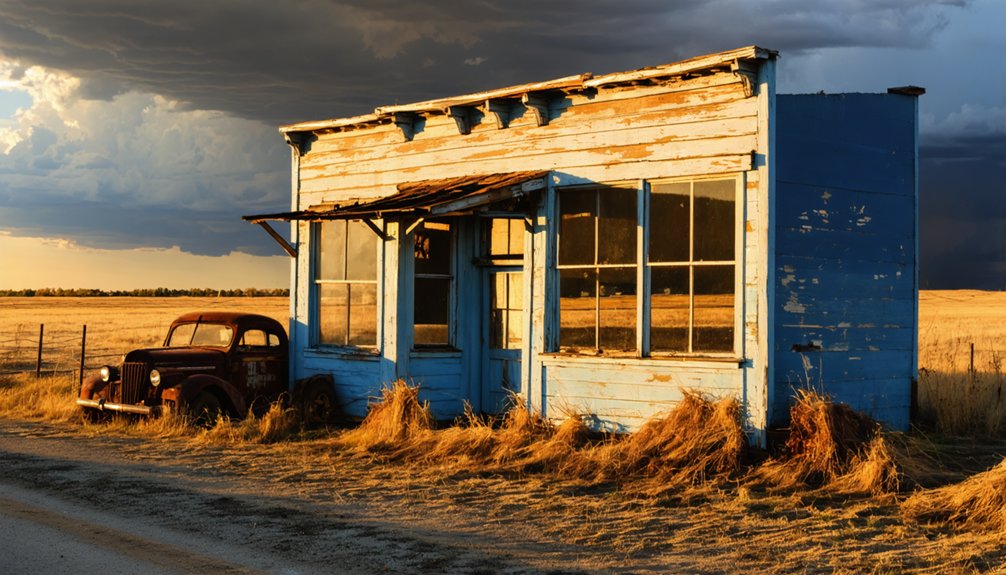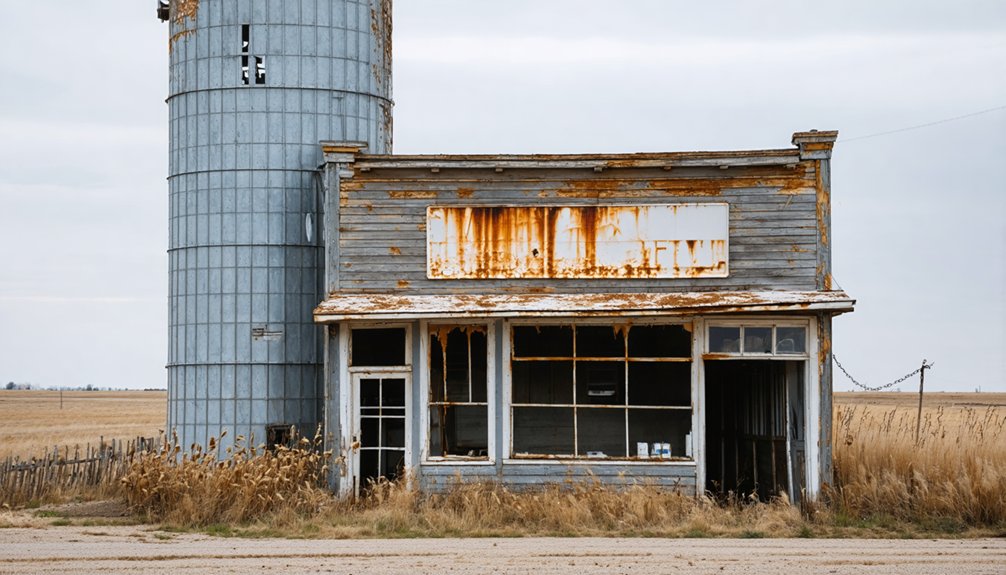The Great Plains’ abandoned towns resulted from a perfect storm of economic, environmental, and technological factors. You’ll find ghost towns created by resource extraction booms, railroad abandonments, and the Dust Bowl’s environmental catastrophe. Communities collapsed when single industries failed, transportation networks changed, or severe drought struck. These settlements transformed from thriving communities to archaeological sites within decades, their empty buildings serving as monuments to the region’s boom-and-bust cycles. Their stories reveal much about human adaptation and resilience.
Key Takeaways
- Resource booms (oil, coal, farming) created rapid town development followed by economic collapse when resources depleted or prices fell.
- Railroad abandonment and diesel technology eliminated the need for maintenance stops, devastating towns established as service points.
- Environmental catastrophes like the Dust Bowl forced mass exodus, with 2.5 million refugees fleeing failing farms and businesses.
- Monocultural agricultural practices destroyed natural prairie ecosystems and left communities vulnerable to economic and environmental collapse.
- Abandoned Great Plains settlements now serve as archaeological treasures that document patterns of human adaptation and resilience.
The Boom and Bust Cycle: How Resource Extraction Shaped Settlement Patterns
While many factors influenced settlement patterns across the Great Plains, resource extraction emerged as a particularly powerful force that repeatedly transformed the landscape through dramatic cycles of growth and abandonment.
You’ll find that these patterns began with the 1893 oil discovery near Neodesha, Kansas, which triggered rapid development, including Standard Oil’s 1902 refinery.
The resource cycle was predictable yet devastating. Towns exploded around extraction sites with high wages (up to 59% above normal) attracting workers despite harsh conditions.
Boom towns emerged from dusty plains as resources lured workers with premium wages despite punishing environments.
However, poor resource management often led to depletion, price collapses, and subsequent abandonment. The North Texas oil boom that began with the Electra field discovery in 1911 created numerous boomtowns across the region that later faced economic challenges when production declined. Coal mining towns, especially in the Raton Basin along the Colorado-New Mexico border, experienced similar fates as mining operations ceased following the Ludlow Massacre and subsequent labor conflicts.
Railroad Lifelines: When the Trains Stopped Coming
You’ll observe how railroad abandonment functioned as a death sentence for countless Great Plains communities, where the economic lifeline was severed when diesel engines replaced steam locomotives, requiring fewer maintenance stops and operational support.
As rail companies consolidated routes and closed branch lines, towns that had flourished as railroad hubs faced immediate economic collapse, with grain elevators standing empty and businesses shuttering within months. This was particularly devastating across the Interior Plains region, stretching from the western Canadian provinces through the central United States. Ottawa, Kansas exemplifies this pattern, as the town experienced significant economic struggles after the last train passed over thirty years ago.
The communities left behind experienced rapid population exodus, transforming once-vibrant social centers into hollow shells where abandoned depots and commercial buildings stand as silent monuments to the railroad era that birthed and ultimately doomed them.
The Lifeline Severed
As railroad companies began severing their connections to small Great Plains communities in the mid-twentieth century, they effectively cut the economic lifelines that had sustained these settlements for generations.
You’d find these towns fundamentally transformed as the ICC’s shifting stance allowed more abandonments when truck competition intensified and unprofitable routes were eliminated. Railroad economics dictated that lines with low traffic and high maintenance costs couldn’t survive, particularly as improved highway infrastructure emerged. The rise of automobiles and trucks significantly contributed to the decline in railroad usage throughout Nebraska and the Great Plains.
When trains stopped coming, you’d witness immediate effects on community infrastructure. Property values plummeted while agricultural shipping options vanished.
Towns that existed solely for railroad operational needs—water stops or maintenance points—often disappeared entirely. For residents, this meant profound social disconnection as their access to markets diminished.
Many communities that had structured their daily rhythms around train schedules suddenly found themselves isolated, abandoned, and ultimately forgotten.
Diesel Engine Revolution
The diesel locomotive revolution that swept across American railroads in the mid-twentieth century transformed not only transportation technology but also the very existence of countless Great Plains communities.
You could witness this diesel innovation beginning in the 1920s, accelerating during World War II when General Motors’ Electro-Motive Division demonstrated superior operational efficiency and range.
The locomotive impact proved devastating for small railroad towns. As diesel engines eliminated the need for frequent water and coal stops, communities established as service points lost their primary function. The transition from steam to diesel-electric locomotives created a massive shift as these newer engines required less maintenance and produced fewer emissions than their predecessors. These engines could run longer distances without stopping, further reducing the need for intermediate service towns.
Towns that once bustled with railroad activity—providing fuel, maintenance, and crew changes—suddenly became unnecessary to railway operations. This technological advancement, while representing progress for the railroad companies, simultaneously severed economic lifelines for numerous settlements across the Plains, accelerating their abandonment and decline.
Communities Left Behind
When railroad companies began systematically removing stations and tracks from remote Great Plains communities in the mid-20th century, they severed critical lifelines that had sustained these towns for generations.
These settlements, originally designed as operational nodes along rail routes, rapidly deteriorated without their economic foundation. Community legacy was profoundly altered as businesses closed, populations declined, and cultural cohesion dissolved. The Dust Bowl era further accelerated abandonment of many Great Plains farming communities already struggling with economic hardship.
- Water towers that once supplied steam engines stood abandoned, symbols of prosperity transformed into monuments of decay.
- Former railroad hotels with peeling paint and broken windows testify to the abrupt cessation of commercial activity.
- Empty grain elevators loom over vacant main streets, embodiments of agricultural prosperity extinguished by transportation shifts.
The cultural nostalgia for railroad towns persists in collective memory, documenting how these communities—once vibrant centers of commerce—withered when their rail connections disappeared, becoming artifacts of America’s westward expansion.
Dust Bowl Devastation: Environmental Catastrophe and Community Collapse
As you travel through the abandoned towns of the Great Plains, you’ll witness the aftermath of the “perfect drought convergence” that combined multi-year rainfall deficits with high temperatures and destructive farming practices to create the Dust Bowl catastrophe.
The mass exodus patterns revealed clear demographic shifts as over 2.5 million environmental refugees fled failing farms and businesses, leaving behind ghost towns where once-thriving communities stood. The transformation of prairie grasslands into wheat fields eliminated natural protections against erosion and contributed significantly to the disaster.
Community resilience failed when economic, agricultural, and social structures collapsed simultaneously under the weight of crop failures, topsoil loss, and widespread dust pneumonia that claimed thousands of lives. The infamous Black Sunday dust storm in 1935 dramatically illustrated the environmental devastation as it carried precious topsoil all the way to the East Coast.
Perfect Drought Convergence
Natural and anthropogenic factors converged in the Great Plains during the 1930s to create what meteorologists now recognize as a “perfect drought” scenario.
You’re witnessing the catastrophic intersection of ocean temperature anomalies, atmospheric dust loading, and human-driven land degradation. The exposed topsoil, stripped of native prairie grasses, became vulnerable to erosive winds while Pacific temperature shifts altered precipitation patterns—a feedback loop that devastated communities lacking drought resilience.
- Settlers’ intensive wheat cultivation transformed 100 million acres of protective grassland into unstable, bare soil.
- Dust particles reflected sunlight back to space, creating anomalous temperatures that further suppressed rainfall.
- Without soil conservation practices, each dust storm removed up to 75% of remaining topsoil, ensuring complete agricultural collapse.
Mass Exodus Patterns
The catastrophic environmental conditions of the 1930s Dust Bowl triggered what historians now recognize as one of America’s largest internal migrations, displacing over 500,000 people from their Great Plains homes in a desperate search for survival.
You’d find entire families—not just individuals—fleeing Oklahoma, Texas, and neighboring states, with nearly 287,000 southern plains residents relocating to California alone between 1935-1940.
Migration motivations transcended simple environmental factors; they represented a complex interplay of drought, economic collapse, and community disintegration.
As you examine migration patterns, you’ll notice California’s San Joaquin Valley became the primary destination.
The cultural impacts proved significant, as migrants faced derogatory labeling as “Okies” and experienced discrimination, fundamentally altering both the abandoned Plains communities and their destination regions.
Community Resilience Failures
Behind the mass exodus of Great Plains residents lay a profound failure of community resilience that unfolded across multiple dimensions.
As social networks disintegrated, traditional community engagement mechanisms collapsed under the weight of environmental and economic devastation. The dissolution of churches, civic organizations, and local governments eliminated essential support structures precisely when they were most needed.
- Psychological trauma intensified as neighbors witnessed the abandonment of multi-generational homesteads and the transformation of vibrant communities into ghost towns.
- Local governments’ inability to maintain vital services accelerated community breakdown when tax revenues evaporated alongside the topsoil.
- Communities’ social fabric, once characterized by mutual aid systems, unraveled as individual survival superseded collective welfare.
This systemic collapse of resilience mechanisms left remaining residents isolated and vulnerable, accelerating the region’s abandonment as hope for recovery diminished.
Mapping Abandonment: Geographic Distribution of Ghost Towns
Mapping the geographic distribution of ghost towns across America reveals striking patterns of abandonment concentrated primarily in the Great Plains and Western states.
The ghost town geography highlights how Texas leads with over 550 abandoned settlements, while states like Oklahoma, Kansas, and South Dakota each contain more than 240.
Regional abandonment appears most pronounced in counties like Wilson County, Texas (30+ ghost towns), Kern County, California (113), and Lawrence County, South Dakota (93).
Interactive mapping tools featuring 3,000-4,500 markers illuminate these patterns through heat maps that visualize density clusters.
While the Great Plains represents a major abandonment hotspot, the Northeast shows considerably fewer ghost towns, with Rhode Island and Connecticut claiming merely 1-4 each.
The Route 66 corridor states form another notable cluster of these forgotten places.
Economic Monocultures: The Dangers of Single-Industry Dependencies

While diverse farming practices initially characterized early settlement across the Great Plains, a dangerous shift toward economic monocultures ultimately sealed the fate of countless communities throughout the region.
This transformation accelerated after World War I when industrialization and mechanization favored large-scale single-crop operations. Towns dependent on a single agricultural commodity became extraordinarily vulnerable when markets inevitably fluctuated.
Without economic diversification, these communities faced:
- Catastrophic collapse when crop prices fell, forcing farmers to plant even more of the same crop to cover mounting debts.
- Environmental devastation as monoculture depleted soil fertility, culminating in the Dust Bowl’s destruction.
- Irreversible population decline as farms consolidated, undermining community sustainability and leading to abandoned schools, churches, and entire towns.
The ghost towns dotting today’s landscape stand as stark monuments to the perils of single-industry dependency.
Vanishing Social Institutions: Schools, Churches, and Community Centers
Three fundamental social institutions—schools, churches, and community centers—formed the structural backbone of Great Plains communities before their dramatic decline throughout the twentieth century.
You’ll find institutional decay manifested dramatically through school consolidations, where plummeting enrollments forced high school closures across rural Nebraska, severing critical community anchors and accelerating outmigration.
Religious institutions suffered similar fates as Lutheran churches in towns like Whitman, North Dakota dwindled to mere twelve-member congregations, transforming from vibrant gathering spaces to barely functional shells.
Community disintegration accelerated when commercial and social venues—bars, general stores, and grain elevators—disappeared simultaneously.
This institutional collapse wasn’t arbitrary but directly reflected demographic reality: with North Dakota losing population in all but six counties during the 1990s, the social infrastructure simply couldn’t survive when its human foundation eroded.
Transportation Revolution: How Technological Change Isolated Communities

The rapid transformation of transportation systems across the Great Plains paralleled the collapse of social institutions, yet ultimately accelerated community abandonment through paradoxical connectivity patterns.
You’ll find that while stagecoach routes and overland trails initially connected isolated settlements, railroads redrew the map entirely. Communities without rail access quickly withered, victims of technological shifts that privileged certain geographic nodes over others.
The iron road’s arrival became both savior and executioner, selecting winners and losers through the simple placement of tracks.
- Witness the skeletal remains of once-thriving stagecoach stops, abandoned when railroads rendered them obsolete.
- Consider how railroad companies wielded power to determine which towns would prosper and which would die.
- Recognize the irony that modern highways later bypassed many railroad towns, creating new cycles of isolation.
These transportation impacts continued through the 20th century as rural rail abandonment further disconnected communities from markets and services.
Demographic Decline: Migration Patterns and Population Loss Since 1920
Since 1920, the Great Plains has experienced a dramatic demographic transformation characterized by persistent rural exodus and concentrated urban growth.
You’ll find stark evidence of this rural decline in the statistics: over two-thirds of counties lost population between 1900 and 2010, with some areas suffering losses exceeding 80% of their residents.
These demographic shifts created a tale of two plains. While rural counties hemorrhaged over half a million people and saw population densities drop below two persons per square mile, metropolitan areas doubled in size.
The culprits behind this transformation included agricultural mechanization, the 1980s farm crisis, and improved transportation networks that made urban centers more accessible.
The consequences remain visible today in approximately 6,000 ghost towns in Kansas alone—sobering monuments to communities that couldn’t withstand these powerful economic currents.
Preserving the Past: Archaeological Significance of Abandoned Settlements

While modern observers might view abandoned settlements as merely decaying remnants of failed dreams, archaeological research reveals these sites as invaluable repositories of cultural knowledge spanning thousands of years of human habitation on the Great Plains.
Through rigorous archaeological methods, researchers uncover seasonal migration patterns, subsistence strategies, and complex social transformations that shaped these landscapes. Material culture—from pit houses to projectile points—offers critical insights where written records fail.
- Each fragment of pottery you discover connects you to hands that shaped clay centuries ago
- Excavated trade goods reveal your ancestors’ vast networks of exchange and communication
- Uncovered village layouts let you walk through spaces where communities gathered, celebrated, and endured
These abandoned towns represent freedom’s physical record—places where diverse peoples adapted to challenging environments through ingenuity and resilience.
Frequently Asked Questions
What Happened to Residents’ Personal Belongings When Towns Were Abandoned?
You’ll find personal effects strewn across floors, with dishes on tables and pans on stoves, effectively transforming abandoned homes into unintentional historical artifacts of hastily interrupted lives.
Are Any Ghost Towns Protected by Historical Preservation Laws?
Yes, you’ll find numerous ghost towns protected through state and federal historical site regulations. Colorado’s ghost town preservation laws and the Archaeological Resources Protection Act specifically shield these cultural treasures from destruction.
How Did Native American Communities Respond to Ghost Town Formation?
You’ll find Native American communities responded with cultural resilience, reclaiming lands for traditional practices. Their historical interactions with ghost towns enabled negotiation for greater rights and development of heritage-based economic opportunities.
Can Abandoned Town Properties Still Be Legally Purchased Today?
Yes, you can legally purchase abandoned town properties, but you’ll need to establish clear legal ownership through title searches and address fragmented property rights issues before finalizing any acquisition.
What Wildlife Now Inhabits These Abandoned Great Plains Settlements?
Like pioneers reclaiming frontier lands, wildlife has adapted to these ghost towns. You’ll find coyotes, badgers, rabbits, burrowing owls, and various birds demonstrating remarkable ecosystem recovery within abandoned structures and surrounding prairie.
References
- https://plainshumanities.unl.edu/encyclopedia/doc/egp.ct.024.html?stream=top
- https://core.ac.uk/download/pdf/345016075.pdf
- https://www.geotab.com/ghost-towns/
- https://en.wikipedia.org/wiki/Wikipedia:WikiProject_Ghost_towns
- https://www.legendsofamerica.com/gt-emergingghosttowns/
- https://figshare.le.ac.uk/articles/thesis/The_Archaeology_of_Abandonment_Ghost_Towns_of_the_American_West/10120007
- https://en.wikipedia.org/wiki/Ghost_town
- https://www.youtube.com/watch?v=zRfBNdUOgOQ
- https://boards.straightdope.com/t/abandoned-prairie-towns-what-caused-it/567962
- https://www.kbia.org/agriculture/2017-03-22/great-plains-ghost-town-sheds-light-on-forgotten-piece-of-african-american-history



